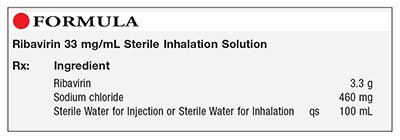US Pharm. 2014;39(7):44-45.

Method of Preparation: Note—This formulation should be prepared according to strict aseptic compounding technique in a laminar airflow hood in a cleanroom or via isolation barrier technology by a compounding pharmacist who is validated in aseptic compounding. This is a high-risk preparation.
Calculate the quantity of each ingredient for the amount to be prepared. Accurately weigh or measure each ingredient. Dissolve the ribavirin and sodium chloride in sufficient Sterile Water for Injection or Sterile Water for Inhalation to final volume and mix well. Filter mixture into appropriate sterile containers. Package and label.
Use: This preparation has been used to treat respiratory syncytial virus infection in hospitalized infants and young children.
Packaging: Package in tight, light-resistant containers.
Labeling: Keep out of reach of children. Discard after ____ [time period].
Stability: Refer to the current edition of the U.S. Pharmacopeia for the appropriate beyond-use date for this compounded sterile preparation.1
Quality Control: Quality-control assessment can include weight/volume, physical observation, pH, specific gravity, osmolality, assay, color, clarity, particulate matter, and sterility.2,3
Discussion: Ribavirin for Inhalation Solution is commercially available as Virazole, which is a sterile, lyophilized powder to be reconstituted for aerosol administration. Each 100-mL glass vial contains 6 g of ribavirin; when reconstituted to 300 mL with Sterile Water for Injection or Sterile Water for Inhalation (no preservatives added), it will contain 20 mg per mL of solution with a pH of approximately 5.5. Ribavirin for Inhalation Solution contains no preservatives and is stable for up to 24 hours when stored under sterile conditions at room temperature.4 This preparation is compounded whenever a different concentration or a small quantity is requested for a specific patient to minimize wastage.
Ribavirin ( Copegus, Rebetol, Ribasphere, Ribatab, RibaPak, Virazole, C8H12N4O5, MW 244.20) occurs as a white, crystalline powder that is freely soluble in water (142 mg/mL at 25°C) and slightly soluble in dehydrated alcohol.1
Ribavirin for Inhalation Solution, USP, is a sterile, freeze-dried form of ribavirin. When constituted as directed in the labeling, the inhalation solution so obtained contains NLT 95.0% and NMT 105.0% of the labeled amount of ribavirin. The solution must meet the USP Sterility Test <71>. The pH of the solution is between 4.0 and 6.5. It should be packaged in tight containers, in a dry place at controlled room temperature. The label should state that the solution must be constituted with a measured volume of Sterile Water for Injection or Sterile Water for Inhalation containing no preservatives, and that the constituted solution is to be administered only by a small-particle aerosol generator.1
Sodium chloride ( NaCl, MW 58.44) is available as a white, crystalline powder or as colorless crystals. It is used to prepare isotonic solutions, among other uses. Sodium chloride is soluble in water (1 g in 2.8 m L), glycerin (1 g in 10 mL), and 95% ethanol (1 g in 250 mL). A 0.9% w/v aqueous solution is iso-osmotic with serum, and its solutions are stable.5
Sterile Water for Injection, USP, is Water for Injection, USP, that has been sterilized and suitably packaged; it contains no added substances. Sterile Water for Inhalation, USP, is prepared from Water for Injection, USP, that is sterilized and suitably packaged. It contains no added antimicrobial agents. (Note—Do not use Sterile Water for Inhalation for parenteral administration or for other sterile compendial dosage forms.) Water for Injection, USP, is water purified by distillation or by reverse osmosis and contains no added substances. Note that Water for Injection is not prepared by an ion-exchange process. Water has a specific gravity of 0.9971 at room temperature, a melting point at 0°C, and a boiling point at 100°C. Water is miscible with most polar solvents and is chemically stable in all physical states (i.e., ice, liquid, and steam).6
REFERENCES
1. U.S
. Pharmacopeia 36/National Formulary 31. Rockville, MD: U.S.
Pharmacopeial Convention,
Inc; 2013:335-398,1285,5032-5033.
2. Allen LV Jr. Standard operating procedure for particulate testing for sterile products. IJPC. 1998;2:78.
3. Allen LV Jr. Standard operating procedure: quality assessment for injectable solutions. IJPC. 1999;3:406-407.
4.
McEvoy GK, ed. AHFS Drug Information 2012. Bethesda, MD: American Society
of Health-System Pharmacists; 2012:827-840.
5.
Maximilien JS. Sodium chloride. In: Rowe RC,
Sheskey PJ, Cook WG, Fenton ME, eds. Handbook of Pharmaceutical Excipients. 7th ed. Washington, DC: American Pharmaceutical Association; 2012:729-732.
6.
Dubash D, Shah U. Water. In: Rowe RC,
Sheskey PJ, Cook WG, Fenton ME, eds. Handbook of Pharmaceutical Excipients. 7th ed. Washington, DC: American Pharmaceutical Association; 2012:880-884.
To comment on this article, contact rdavidson@uspharmacist.com.





